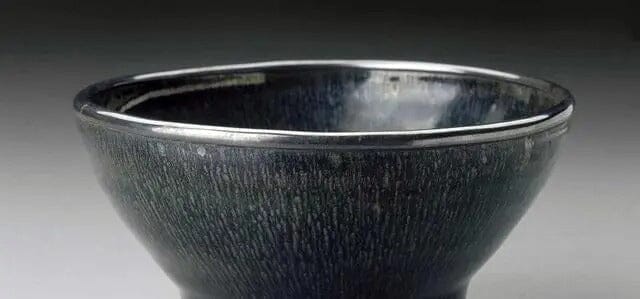Regarding the inquiry from a teaware enthusiast: "For a newly acquired Tenmoku cup, do I need to scald it with boiling water or boil it before use?" In fact, the treatment method varies for new and old Tenmoku cups.
For a new Tenmoku cup, it is not as complicated as seasoning a Yixing teapot. It only needs to be cleaned before use. You can use toothpaste or a cleaning cloth to wipe it, then rinse it thoroughly with clean water, and soak it in hot water or tea soup for at least half an hour. Since Tenmoku cups inevitably pass through different people's hands from production to sale, to use them with peace of mind, I think it would be better to boil them in hot water for a few minutes.

- Normally, after finishing the last cup of tea every day, rinse the Tenmoku cup with hot water to remove any tea stains attached to the glaze surface, and then leave the cup to air dry in a well-ventilated area. Alternatively, you can wipe it clean with a specialized tea cloth.
- Every three to five days, conduct a thorough cleaning of the Tenmoku cup (you can use a cleaning cloth or toothpaste to clean it).
For old Tenmoku cups, in this context, "old" refers to "excavated old Tenmoku cups". Some teaware enthusiasts particularly enjoy collecting excavated old Tenmoku cups. However, these cups have been buried in the soil for a long time, and the natural taste of the soil will also enter the cup, causing an earthy smell that can affect the taste of the tea. Here are some methods that teaware enthusiasts can try to minimize the "earthy smell":
- Soak the Tenmoku cup in a diluted solution of vinegar for a short period of time.
- Prepare two toothbrushes (one soft and one hard) and a scrubbing sponge.
- Add some salt to water and use the scrubbing sponge to remove any soil stains on the cup.
- Use the hard-bristled toothbrush to clean any stubborn dirt.
- Use the soft-bristled toothbrush to clean the details and finer areas of the cup.
- Rinse repeatedly with clean water, and then place the cup in a boiling pot of water on low heat for half an hour, repeating the process several times, but remember to change the water.
- Remove the Tenmoku cup from the hot water and let it cool to room temperature, then soak it in cold water, repeating the above steps.
After the above treatment, the excavated old Tenmoku cup can be used again. You can also boil it in tea water on low heat. Of course, it also needs your long-term and careful care to restore its vitality.
Suggestion:
(1) Not all so-called "old Tenmoku" cups are suitable for drinking tea. Those brightly colored cups that are clearly modern imitations of "old Tenmoku" should not be used for tea drinking.
(2) Excavated Tenmoku cups have been buried deep in the soil for thousands of years, and the glaze surface may have been eroded over time, leaving stains and flaws. Many Tenmoku cups that have been buried in the soil are also damaged, so we should not demand too much perfection from them.









Share:
The aristocrat in the world of Tenmoku - Wu Jin glaze
Tenmoku Pottery: Understand in 3 Minutes